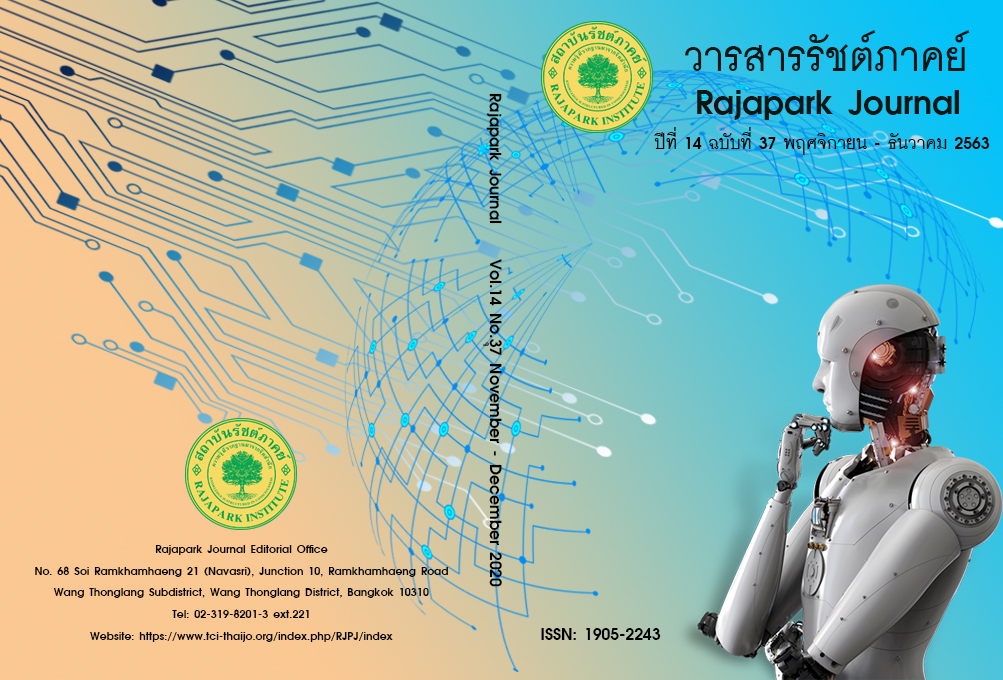มาตรการทางกฎหมายเกี่ยวกับการคุ้มครองสิทธินักออกแบบท่าเต้น
Main Article Content
บทคัดย่อ
ปัจจุบันธุรกิจบันเทิงได้รับความนิยมเป็นอย่างมาก ธุรกิจดังกล่าวประกอบด้วยหลายแขนงด้วยกัน อาทิเช่น การแสดงละคร ภาพยนตร์ การร้องเพลง การแสดงละครเวที การเต้นซึ่งรวมไปถึงการออกแบบท่าเต้นด้วย เป็นต้น นักออกท่าเต้นเปรียบเสมือนครูของนักเต้น หรือผู้ทำการแสดงเกี่ยวกับการเต้นที่แสดงเรื่องราว นักออกแบบท่าเต้นนั้นเป็นผู้สร้างสรรค์ผลงานขึ้นมาย่อมต้องได้รับความคุ้มครองในฐานะเจ้าของลิขสิทธิ์ จากการศึกษากฎหมายในประเทศไทยพบว่า การออกแบบท่าเต้นนั้นยังไม่ได้รับความคุ้มครองลิขสิทธิ์แต่อย่างใด และกฎหมายลิขสิทธิ์ยังไม่ครอบคลุมถึงนักออกแบบท่าเต้น เพื่อศึกษาปัญหาเรื่องดังกล่าวจึงจำเป็นต้อง ศึกษาและวิเคราะห์การคุ้มครองสิทธิของนักออกแบบท่าเต้นที่ได้รับการคุ้มครองตามกฎหมายลิขสิทธิ์ของประเทศไทยเปรียบเทียบกับกฎหมายลิขสิทธิ์ระหว่างประเทศและกฎหมายลิขสิทธิ์ต่างประเทศ ใช้รูปแบบการศึกษาเชิงคุณภาพ การวิจัยครั้งนี้ใช้วิธีวิจัยทางเอกสาร Document Research วิเคราะห์เปรียบเทียบจากตำรา บทความทางวิชาการ รายงาน งานวิจัย วิทยานิพนธ์ วารสาร และการค้นคว้าจากข้อมูลทางสื่ออิเล็กทรอนิกส์ และผลการวิจัยพบว่าประเทศไทยไม่ได้ให้การคุ้มครองสิทธิของนักออกแบบท่าเต้นไว้ ควรนำกฎหมายของต่างประเทศที่ให้การคุ้มครองลิขสิทธิ์การออกแบบท่าเต้น (1) ควรกำหนดบทนิยามเพิ่มเติมในพระราชบัญญัติลิขสิทธิ์ พ.ศ. 2537 ให้ครอบคลุมถึงการออกแบบท่าเต้น (2) การออกแบบท่าเต้นที่ได้รับความคุ้มครองนั้นท่าเต้น ต้องไม่ใช่ Social dance ท่าเต้นทางสังคมที่เคลื่อนไหวทั่วไป อีกทั้งต้องมีการประยุกต์ท่าเต้นเพื่อให้เกิดงานสร้างสรรค์ใหม่ ๆ เกิดขึ้น และระดับการคุ้มครองต้องได้รับความคุ้มครองตามมาตรฐานขั้นต่ำของกฎหมายลิขสิทธิ์
Article Details
ทัศนะและความคิดเห็นที่ปรากฏในวารสาร ถือเป็นความรับผิดชอบของผู้เขียนบทความนั้น และไม่ถือเป็นทัศนะและความรับผิดชอบของกองบรรณาธิการ
เอกสารอ้างอิง
Ausdance. (2012). Copyright for the dance industry. Retrieved October 21, 2018, from https://ausdance.org.au/articles/details/copyright-for-the-dance-industry
Copyright Registration of Choreography and Pantomime (Circular 52), United States Copyright Office. Retrieved April 24, 2018, from https://www.copyright.gov/circs/circ52.pdf
Eastland, James O. (1961). COPYRIGHT LAW REVISION 28. Copyright in Choreographic Works. Retrieved April 24, 2018, from https://www.copyright.gov/history/studies/study28.pdf
Hemaratchata, C. (2010). Description of copyright law. Bangkok: Nititham.
Hemaratchata, C. (2017). Characteristics of intellectual property law (basic). Bangkok: Nititham.
Lertdhamtewe, P. (2014). Choreographer' Rights in the Thai Intellectual Property Jurisprudence. The Intellectual property and International Trade Law Journal, Special 17, 217-228. https://esv-ipitc.coj.go.th/ebook/ipitc_website /17th_anniversary_(table_of_contents) /index.html
Lertdhamtewe, P. (2019). Knowledge of Intellectual property law (3rd ed.). Bangkok: winyuchon.
Netayasupha, A., & Arreewittayalerd, C. (2015). Description of copyright law. Bangkok: Winyuchon.
Panuspatthna, O. (2014). Description of copyright law (6th ed.). Bangkok: Chulalongkorn University.
Sripiboon, W. (2005). Include a description with case: intellectual property law (3rd ed.). Bangkok: Tippayada.
Sriterawisarn, W. (2016). Copyright Protection of Graphic Design on Cheerleader Uniform in United States. Ramkhamhaeng Law Journal, 5(1), 3-24.


